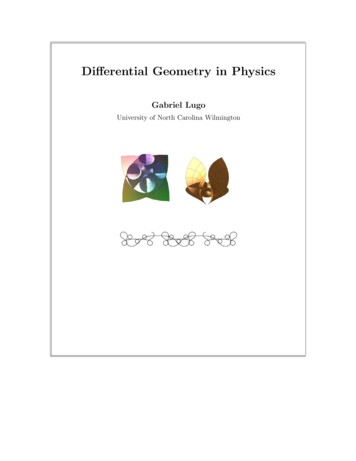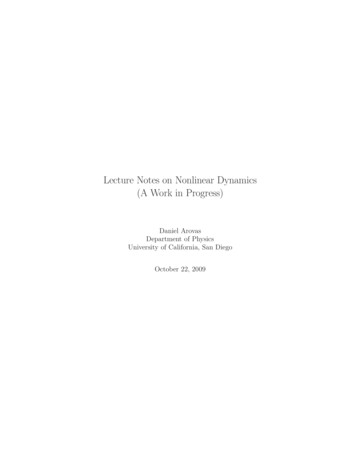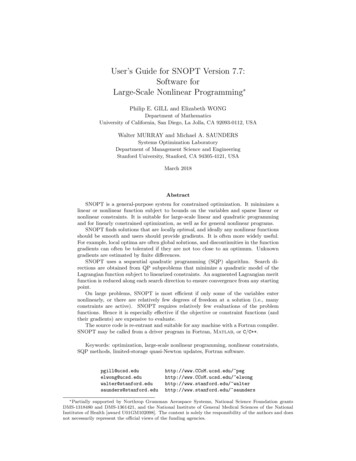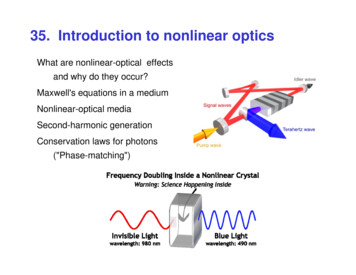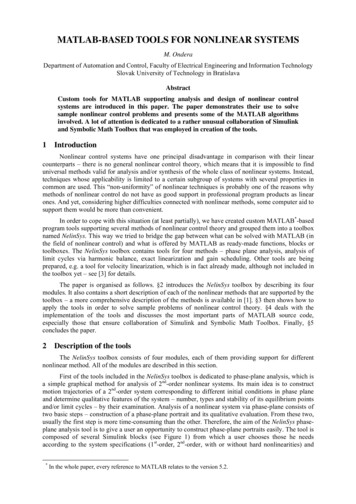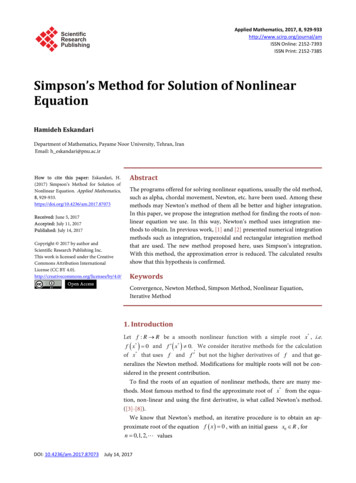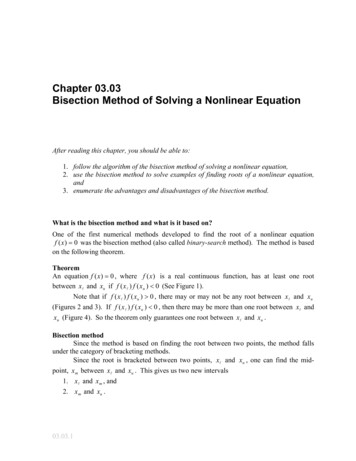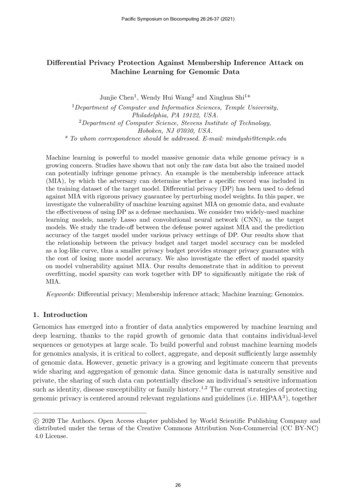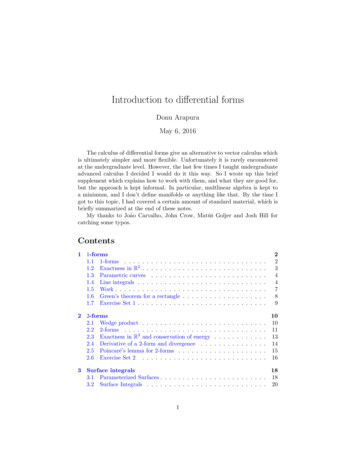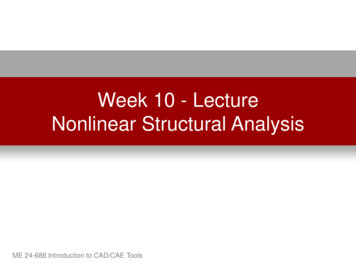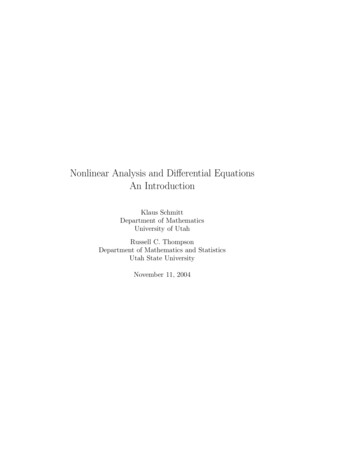
Transcription
Nonlinear Analysis and Differential EquationsAn IntroductionKlaus SchmittDepartment of MathematicsUniversity of UtahRussell C. ThompsonDepartment of Mathematics and StatisticsUtah State UniversityNovember 11, 2004
ii···Copyright c 1998 by K. Schmitt and R. Thompson
iiiPrefaceThe subject of Differential Equations is a well established part of mathematics and its systematic development goes back to the early days of the development of Calculus. Many recent advances in mathematics, paralleled bya renewed and flourishing interaction between mathematics, the sciences, andengineering, have again shown that many phenomena in the applied sciences,modelled by differential equations will yield some mathematical explanation ofthese phenomena (at least in some approximate sense).The intent of this set of notes is to present several of the important existencetheorems for solutions of various types of problems associated with differentialequations and provide qualitative and quantitative descriptions of solutions. Atthe same time, we develop methods of analysis which may be applied to carryout the above and which have applications in many other areas of mathematics,as well.As methods and theories are developed, we shall also pay particular attentionto illustrate how these findings may be used and shall throughout considerexamples from areas where the theory may be applied.As differential equations are equations which involve functions and theirderivatives as unknowns, we shall adopt throughout the view that differential equations are equations in spaces of functions. We therefore shall, as weprogress, develop existence theories for equations defined in various types offunction spaces, which usually will be function spaces which are in some sensenatural for the given problem.
iv
Table of ContentsINonlinear Analysis1Chapter I. Analysis In Banach Spaces1Introduction . . . . . . . . . . . . .2Banach Spaces . . . . . . . . . . .3Differentiability, Taylor’s Theorem4Some Special Mappings . . . . . .5Inverse Function Theorems . . . .6The Dugundji Extension Theorem7Exercises . . . . . . . . . . . . . .333811202225Chapter II. The Method of Lyapunov-Schmidt271Introduction . . . . . . . . . . . . . . . . . . . . . . . . . . . . . . 272Splitting Equations . . . . . . . . . . . . . . . . . . . . . . . . . . 273Bifurcation at a Simple Eigenvalue . . . . . . . . . . . . . . . . . 30Chapter III. Degree Theory1Introduction . . . . . . . . . . . . . . .2Definition . . . . . . . . . . . . . . . .3Properties of the Brouwer Degree . . .4Completely Continuous Perturbations5Exercises . . . . . . . . . . . . . . . .Chapter IV. Global Solution Theorems1Introduction . . . . . . . . . . . . . . . .2Continuation Principle . . . . . . . . . .3A Globalization of the Implicit Function4The Theorem of Krein-Rutman . . . . .5Global Bifurcation . . . . . . . . . . . .6Exercises . . . . . . . . . . . . . . . . .II.333333384247. . . . . . . . . . .Theorem. . . . . . . . . . . . . . . .49494952545761.Ordinary Differential EquationsChapter V. Existence and Uniqueness Theoremsv.6365
viTABLE OF CONTENTS12345678Introduction . . . . . . . . . . . . . .The Picard-Lindelöf Theorem . . . .The Cauchy-Peano Theorem . . . . .Extension Theorems . . . . . . . . .Dependence upon Initial ConditionsDifferential Inequalities . . . . . . .Uniqueness Theorems . . . . . . . .Exercises . . . . . . . . . . . . . . .Chapter VI. Linear Ordinary Differential1Introduction . . . . . . . . . . . . . . .2Preliminaries . . . . . . . . . . . . . .3Constant Coefficient Systems . . . . .4Floquet Theory . . . . . . . . . . . . .5Exercises . . . . . . . . . . . . . . . .6566676972747879Equations. . . . . . . . . . . . . . . . . . . . . . . . . . . . . . 123123124125127129131Chapter VII. Periodic Solutions1Introduction . . . . . . . . . . . . . . . .2Preliminaries . . . . . . . . . . . . . . .3Perturbations of Nonresonant Equations4Resonant Equations . . . . . . . . . . .5Exercises . . . . . . . . . . . . . . . . .Chapter VIII. Stability Theory1Introduction . . . . . . . . . . . .2Stability Concepts . . . . . . . .3Stability of Linear Equations . .4Stability of Nonlinear Equations5Lyapunov Stability . . . . . . . .6Exercises . . . . . . . . . . . . .Chapter IX. Invariant Sets1Introduction . . . . . . . .2Orbits and Flows . . . . .3Invariant Sets . . . . . . .4Limit Sets . . . . . . . . .5Two Dimensional Systems6Exercises . . . . . . . . .Chapter X. Hopf Bifurcation1331Introduction . . . . . . . . . . . . . . . . . . . . . . . . . . . . . . 1332A Hopf Bifurcation Theorem . . . . . . . . . . . . . . . . . . . . 133
TABLE OF CONTENTSChapter XI. Sturm-Liouville Boundary Value Problems1Introduction . . . . . . . . . . . . . . . . . . . . . . . . .2Linear Boundary Value Problems . . . . . . . . . . . . .3Completeness of Eigenfunctions . . . . . . . . . . . . . .4Exercises . . . . . . . . . . . . . . . . . . . . . . . . . .vii.139139139142145Bibliography147Index149
viiiTABLE OF CONTENTS
Part INonlinear Analysis1
Chapter IAnalysis In Banach Spaces1IntroductionThis chapter is devoted to developing some tools from Banach space valued function theory which will be needed in the following chapters. We firstdefine the concept of a Banach space and introduce a number of examples ofsuch which will be used later. We then discuss the notion of differentiability ofBanach–space valued functions and state an infinite dimensional version of Taylor’s theorem. As we shall see, a crucial result is the implicit function theoremin Banach spaces, a version of this important result, suitable for our purposesis stated and proved. As a consequence we derive the Inverse Function theoremin Banach spaces and close this chapter with an extension theorem for functions defined on proper subsets of the domain space (the Dugundji extensiontheorem).In this chapter we shall mainly be concerned with results for not necessarilylinear functions; results about linear operators which are needed in these noteswill be quoted as needed.2Banach SpacesLet E be a real (or complex) vector space which is equipped with a normk · k, i.e. a function k · k : E R having the properties:i) kuk 0, for every u E,ii) kuk 0 is equivalent to u 0 E,iii) kλuk λ kuk, for every scalar λ and every u E,iv) ku vk kuk kvk, for all u, v, E (triangle inequality).A norm k · k defines a metric d : E E R by d(u, v) ku vk and(E, k · k) or simply E (if it is understood which norm is being used) is called a3
4Banach space if the metric space (E, d), d defined as above, is complete (i.e. allCauchy sequences have limits in E).If E is a real (or complex) vector space which is equipped with an inner product,i.e. a mappingh·, ·i : E E R (or C (the complex numbers))satisfyingi) hu, vi hv, ui, u, v Eii) hu v, wi hu, wi hv, wi, u, v, w Eiii) hλu, vi λhu, vi, λ C, u, v, Eiv) hu, ui 0, u E, and hu, ui 0 if and only if u 0,then E is a normed space with the norm defined bypkuk hu, ui, u E.If E is complete with respect to this norm, then E is called a Hilbert space.An inner product is a special case of what is known as a conjugate linearform, i.e. a mapping b : E E C having the properties (i)–(iv) above (withh·, ·i replaced by b(·, ·)); in case E is a real vector space, then b is called a bilinearform.The following collection of spaces are examples of Banach spaces. They willfrequently be employed in the applications presented later. The verification thatthe spaces defined are Banach spaces may be found in the standard literatureon analysis.2.1Spaces of continuous functionsLet Ω be an open subset of Rn , defineC 0 (Ω, Rm ) {f : Ω Rm such that f is continuous on Ω}.Letkf k0 sup f (x) ,(1)x Ωwhere · is a norm in Rm .Since the uniform limit of a sequence of continuous functions is again continuous, it follows that the spaceE {f C 0 (Ω, Rm ) : kf k0 }is a Banach space.If Ω is as above and Ω′ is an open set with Ω̄ Ω′ , we let C 0 (Ω̄, Rm ) {therestriction to Ω̄ of f C 0 (Ω′ , Rm )}. If Ω is bounded and f C 0 (Ω̄, Rm ),then kf k0 . Hence C 0 (Ω̄, Rm ) is a Banach space.
2. BANACH SPACES2.25Spaces of differentiable functionsLet Ω be an open subset of Rn . Let β (i1 , · · · , in ) be a multiindex,i.e.Pnik Z (the nonnegative integers), 1 k n. We let β k 1 ik . Letf : Ω Rm , then the partial derivative of f of order β, Dβ f (x), is given by β f (x),· · · in xnDβ f (x) i1 x1where x (x1 , · · · , xn ). Define C j (Ω, Rm ) {f : Ω Rm such that Dβ f iscontinuous for all β, β j}.Letkf kj jXk 0max kDβ f k0 . β k(2)Then, using further convergence results for families of differentiable functions itfollows that the spaceE {f C j (Ω, Rm ) : kf kj }is a Banach space.The space C j (Ω̄, Rm ) is defined in a manner similar to the space C 0 (Ω̄, Rm )and if Ω is bounded C j (Ω̄, Rm ) is a Banach space.2.3Hölder spacesLet Ω be an open set in Rn . A function f : Ω Rm is called Höldercontinuous with exponent α, 0 α 1, at a point x Ω, if f (x) f (y) , x y αy6 xsupand Hölder continuous with exponent α, 0 α 1, on Ω if it is Hölder continuous with the same exponent α at every x Ω. For such f we defineHΩα (f ) supx6 yx,y Ω f (x) f (y) . x y α(3)If f C j (Ω, Rm ) and Dβ f, β j, is Hölder continuous with exponent α onΩ, we say f C j,α (Ω, Rm ). Letkf kj,α kf kj max HΩα (Dβ f ), β jthen the spaceE {f C j,α (Ω, Rm ) : kf kj,α }is a Banach space.
6As above, one may define the space C j,α (Ω, Rm ). And again, if Ω is bounded,C (Ω, Rm ) is a Banach space.We shall also employ the following conventionj,αC j,0 (Ω, Rm ) C j (Ω, Rm )andC j,0 (Ω̄, Rm ) C j (Ω̄, Rm ).2.4Functions with compact supportLet Ω be an open subset of Rn . A function f : Ω Rm is said to havecompact support in Ω if the setsupp f closure{x Ω : f (x) 6 0} {x Ω : f (x) 6 0}is compact.We letC0j,α (Ω, Rm ) {f C j,α (Ω, Rm ) : supp f is a compact subset of Ω}and define C0j,α (Ω̄, Rm ) similarly.Then, again, if Ω is bounded, the space C0j,α (Ω̄, Rm ) is a Banach space andC0j,α (Ω̄, Rm ) {f C j,α (Ω̄, Rm ) : f (x) 0, x Ω}.2.5Lp spacesLet Ω be a Lebesgue measurable subset of Rn and let f : Ω Rm be ameasurable function. Let, for 1 p , Z 1/pppkf kL f (x) dx,Ωand for p , letkf kL essupx Ω f (x) ,where essup denotes the essential supremum.For 1 p , letLp (Ω, Rm ) {f : kf kLp }.Then Lp (Ω, Rm ) is a Banach space for 1 p . The space L2 (Ω, Rm ) is aHilbert space with inner product defined byZf (x) · g(x)dx,hf, gi Ωwhere f (x) · g(x) is the inner product of f (x) and g(x) in the Hilbert space(Euclidean space) Rn .
2. BANACH SPACES2.67Weak derivativesLet Ω be an open subset of Rn . A function f : Ω Rm is said to belong toclass Lploc (Ω, Rm ), if for every compact subset Ω′ Ω, f Lp (Ω′ , Rm ). Let β (β1 , . . . , βn ) be a multiindex. Then a locally integrable function v L1loc (Ω, Rm )is called the β th weak derivative of f if it satisfiesZZvφdx ( 1) β f Dβ φdx, for all φ C0 (Ω).(4)ΩΩWe write v Dβ f and note that, up to a set of measure zero, v is uniquelydetermined. The concept of weak derivative extends the classical concept ofderivative and has many similar properties (see e.g. [18]).2.7setSobolev spacesWe say that f W k (Ω, Rm ), if f has weak derivatives up to order k, andW k,p (Ω, Rm ) {f W k (Ω, Rm ) : Dβ f Lp (Ω, Rm ), β k}.Then the vector space W k,p (Ω, Rm ) equipped with the norm 1/pZ X Dβ f p dx kf kW k,p (5)Ω β kis a Banach space. The space C0k (Ω, Rm ) is a subspace of W k,p (Ω, Rm ), it’sclosure in W k,p (Ω, Rm ), denoted by W0k,p (Ω, Rm ), is a Banach subspace which,in general, is a proper subspace.For p 2, the spaces W k,2 (Ω, Rm ) and W0k,2 (Ω, Rm ) are Hilbert spaces withinner product hf, gi given byZ XDα f · Dα gdx.(6)hf, gi Ω α kThese spaces play a special role in the linear theory of partial differential equations, and in case Ω satisfies sufficient regularity conditions (see [1], [41]), theymay be identified with the following spaces.Consider the space C k (Ω̄, Rm ) as a normed space using the k · kW k,p norm.It’s completion is denoted by H k,p (Ω, Rm ). If p 2 it is a Hilbert space withinner product given by (6). H0k,p (Ω, Rm ) is the completion of C0 (Ω, Rm ) inH k,p (Ω, Rm ).2.8LetSpaces of linear operatorsLet E and X be normed linear spaces with norms k·kE and k·kX , respectively.L(E; X) {f : E X such that f is linear and continuous}.
8For f L(E; X), letkf kL sup kf (x)kX .(7)kxkE 1Then k · kL is a norm for L(E; X). This space is a Banach space, whenever Xis.Let E1 , . . . , En and X be n 1 normed linear spaces, let L(E1 , . . . , En ; X) {f : E1 · · · En X such that f is multilinear (i.e. f is linear in eachvariable separately) and continuous}. Letkf k sup{kf (x1 , . . . , xn )kX : kx1 kE1 1, . . . , kxn kEn 1},(8)then L(E1 , . . . , En ; X) with the norm defined by (8) is a normed linear space.It again is a Banach space, whenever X is.If E and X are normed spaces, one may define the spacesL1 (E; X)L2 (E; X). .L(E; X)L(E; L1 (E; X)).Ln (E; X) L(E; Ln 1 (E; X)), n 2.We leave it as an exercise to show that the spaces L(E, . . . , E; X) (E repeatedn times) and Ln (E; X) may be identified (i.e. there exists an isomorphismbetween these spaces which is norm preserving (see e.g. [43]).3Differentiability, Taylor’s Theorem3.1Gâteaux and Fréchet differentiabilityLet E and X be Banach spaces and let U be an open subset of E. Letf :U Xbe a function. Let x0 U , then f is said to be Gâteaux differentiable (Gdifferentiable) at x0 in direction h, if1lim {f (x0 th) f (x0 )}t 0 t(9)exists. It said to be Fréchet differentiable (F-differentiable) at x0 , if there existsT L(E; X) such thatf (x0 h) f (x0 ) T (h) o(khk)for khk small, here o(khk) means thatlimkhk 0o(khk) 0.khk(10)
3. DIFFERENTIABILITY, TAYLOR’S THEOREM9(We shall use the symbol k · k to denote both the norm of E and the norm ofX, since it will be clear from the context in which space we are working.) Wenote that Fréchet differentiability is a more restrictive concept.It follows from this definition that the Fréchet–derivative of f at x0 , if itexists, is unique. We shall use the following symbols interchangeably for theFréchet–derivative of f at x0 ; Df (x0 ), f ′ (x0 ), df (x0 ), where the latter is usuallyused in case X R. We say that f is of class C 1 in a neighborhood of x0 if fis Fréchet differentiable there and if the mappingDf : x 7 Df (x)is a continuous mapping into the Banach space L(E; X).If the mappingDf : U L(E; X)is Fréchet–differentiable at x0 U , we say that f is twice Fréchet–differentiableand we denote the second F–derivative by D2 f (x0 ), or f ′′ (x0 ), or d2 f (x0 ). ThusD2 f (x0 ) L2 (E; X). In an analogous way one defines higher order differentiability.If h E, we shall writeDn f (x0 )(h, · · · , h) as Dn f (x0 )hn ,(see Subsection 2.8).If f : Rn Rn is Fréchet differentiable at x0 , then Df (x0 ) is given by theJacobian matrixDf (x0 ) fi xjx x0!,and if f : Rn R is Fréchet differentiable, then Df (x0 ) is represented by thegradient vector f (x0 ), i.e.Df (x0 )(h) f (x0 ) · h,where “·” is the dot product in Rn , and the second derivative D2 f (x0 ) is given 2 fby the Hessian matrix x i x, i.e.jx x022D f (x0 )h hT 2f xi xj h,where hT is the transpose of the vector h.
103.2Taylor’s formula1 Theorem Let f : E X and all of its Fréchet–derivatives Df, · · · , Dm f becontinuous on an open set U . Let x and x h be such that the line segmentconnecting these points lies in U . Thenf (x h) f (x) m 1Xk 11 m1 kD f (x)hk D f (z)hm ,k!m!(11)where z is a point on the line segment connecting x to x h. The remainder1mmis also given bym! D f (z)hZ 11(1 s)m 1 Dm f (x0 sh)hm ds.(12)(m 1)! 0We shall not give a proof of this result here, since the proof is similar to the onefor functions f : Rn Rm (see e.g. [14]).3.3Euler-Lagrange equationsIn this example we shall discuss a fundamental problem of variational calculus to illustrate the concepts of differentiation just introduced; specifically weshall derive the so called Euler-Lagrange differential equations. The equationsderived give necessary conditions for the existence of minima (or maxima) ofcertain functionals.Let g : [a, b] R2 R be twice continuously differentiable. Let E C02 [a, b]and let T : E R be given byZ bg(t, u(t), u′ (t))dt.T (u) aIt then follows from elementary properties of the integral, that T is of class C 1 .Let u0 E be such that there exists an open neighborhood U of u0 such thatT (u0 ) T (u)(13)for all u U (u0 is called an extremal of T ). Since T is of class C 1 we obtainthat for u UT (u) T (u0 ) DT (u0 )(u u0 ) o(ku u0 k).Hence for fixed v E and ǫ R small,T (u0 ǫv) T (u0 ) DT (u0 )(ǫv) o( ǫ kvk).It follows from (13) that0 DT (u0 )(ǫv) o( ǫ kvk)and hence, dividing by kǫvk, o(kǫvk)v ,0 DT (u0 ) kvkkǫvk
4. SOME SPECIAL MAPPINGS11where k · k is the norm in E. It therefore follows, letting ǫ 0, that forevery v E, DT (u0 )(v) 0. To derive the Euler–Lagrange equation, we mustcompute DT (u0 ). For arbitrary h E we haveRbT (u0 h) a g(t, u0 (t) h(t), u′0 (t) h′ (t))dtRb a g(t, u0 (t), u′0 (t)dtRb′ a g p (t, u0 (t), u0 (t))h(t)dtR b g a q (t, u0 (t), u′0 (t))h′ (t)dt o(khk),where p and q denote generic second, respectively, third variables in g. ThusZ bZ b g gDT (u0 )(h) (t, u0 (t), u′0 (t))h(t)dt (t, u0 (t), u′0 (t))h′ (t)dt.a pa qFor notation’s sake we shall now drop the arguments in g and its partial derivatives. We computeZba b Z b g ′ gd gdt,h dt h h q q adt qaand since h E, it follows that Z b gd gDT (u0 )(h) hdt. p dt qa(14)Since DT (u0 )(h) 0 for all h E, it follows thatd g g(t, u0 (t), u′0 (t)) (t, u0 (t), u′0 (t)) 0, pdt q(15)for a t b (this fact is often referred to as the fundamental lemma of thecalculus of variations). Equation (15) is called the Euler-Lagrange equation. Ifg is twice continuously differentiable (15) becomes 2g 2g ′ 2g g u0 2 u′′0 0, p t q p q q(16)where it again is understood that all partial derivatives are to be evaluated at(t, u0 (t), u′0 (t)). We hence conclude that an extremal u0 E must solve thenonlinear differential equation (16).4Some Special MappingsThroughout our text we shall have occasion to study equations defined bymappings which enjoy special kinds of properties. We shall briefly review somesuch properties and refer the reader for more detailed discussions to standardtexts on analysis and functional analysis (e.g. [14]).
124.1Completely continuous mappingsLet E and X be Banach spaces and let Ω be an open subset of E, letf :Ω Xbe a mapping. Then f is called compact, whenever f (Ω′ ) is precompact inX for every bounded subset Ω′ of Ω (i.e. f (Ω′ ) is compact in X). We call fcompletely continuous whenever f is compact and continuous. We note that iff is linear and compact, then f is completely continuous.2 Lemma Let Ω be an open set in E and let f : Ω X be completely continuous,let f be F-differentiable at a point x0 Ω. Then the linear mapping T Df (x0 )is compact, hence completely continuous.Proof. Since T is linear it suffices to show that T ({x : kxk 1}) is precompactin X. (We again shall use the symbol k · k to denote both the norm in E andin X.) If this were not the case, there exists ǫ 0 and a sequence {xn } n 1 E, kxn k 1, n 1, 2, 3, · · · such thatkT xn T xm k ǫ, n 6 m.Choose 0 δ 1 such thatkf (x0 h) f (x0 ) T hk ǫkhk,3for h E, khk δ. Then for n 6 mkf (x0 δxn ) f (x0 δxm )k δkT xn T xm k kf (x0 δxn ) f (x0 ) δT xn k kf (x0 δxm ) f (x0 ) δT xm k δǫ δǫ3 δǫ3 δǫ3 .Hence the sequence {f (x0 δxn )} n 1 has no convergent subsequence. On theother hand, for δ 0, small, the set {x0 δxn } n 1 Ω, and is bounded,implying by the complete continuity of f that {f (x0 δxn )} n 1 is precompact.We have hence arrived at a contradiction.4.2Proper mappingsLet M E, Y X and let f : M Y be continuous, then f is calleda proper mapping if for every compact subset K of Y , f 1 (K) is compact inM . (Here we consider M and Y as metric spaces with metrics induced by thenorms of E and X, respectively.)
4. SOME SPECIAL MAPPINGS133 Lemma Let h : E X be completely continuous and let g : E X be proper,then f g h is a proper mapping, provided that f is coercive, i.e.kf (x)k as kxk .(17)Proof. Let K be a compact subset of X and let N f 1 (K). Let {xn } n 1be a sequence in N . Then there exists {yn } n 1 K such thatyn g(xn ) h(xn ).(18)Since K is compact, the sequence {yn } n 1 has a convergent subsequence, andsince f is coercive the sequence {xn } n 1 must be bounded, further, becauseh is completely continuous, the sequence {h(xn )} n 1 must have a convergentsubsequence. It follows that the sequence {g(xn )} n 1 has a convergent subsequence. Relabeling, if necessary, we may assume that all three sequences {yn } n 1 , {g(xn )}n 1 and {h(xn )}n 1 are convergent. Sinceg(xn ) yn h(xn )and g is proper, it follows that {xn } n 1 converges also, say xn x; hence Nis precompact. That N is also closed follows from the fact that g and h arecontinuous.4 Corollary Let h : E E be a completely continuous mapping, and let f id h be coercive, then f is proper (here id is the identity mapping).Proof. We note that id : E E is a proper mapping.In finite dimensional spaces the concepts of coercivity and properness areequivalent, i.e. we have:5 Lemma Let f : Rn Rm be continuous, then f is proper if and only if f iscoercive.4.3Contraction mappings, the Banach fixed point theoremLet M be a subset of a Banach space E. A function f : M E is called acontraction mapping if there exists a constant k, 0 k 1 such thatkf (x) f (y)k kkx yk, for all x, y M.(19)6 Theorem Let M be a closed subset of E and f : M M be a contractionmapping, then f has a unique fixed point in M ; i.e. there exists a unique x Msuch thatf (x) x .(20)
14Proof. If x, y M both satisfy (20), thenkx yk kf (x) f (y)k kkx yk,hence, since k 1, x must equal y, establishing uniqueness of a fixed point.To proof existence, we define a sequence {xn } n 0 M inductively as follows:Choose x0 M and letxn f (xn 1 ), n 1.(21)(21) implies that for any j 1kf (xj ) f (xj 1 )k k j kx1 x0 k,and hence if m nxm xn xm xm 1 xm 1 . . . xn 1 xnf (xm 1 ) f (xm 2 ) . . . f (xn ) f (xn 1 )and thereforekxm xn k kx1 x0 k(k n . . . k m 1 ) kn kmkx1 x0 k.1 k(22)It follows from (22) that {xn } n 0 is a Cauchy sequence in E, hencelim xn xn exists and since M is closed, x M . Using (21) we obtain that (20) holds.7 Remark We note that the above theorem, Theorem 6, also holds if E is acomplete metric space with metric d. This is easily seen by replacing kx yk byd(x, y) in the proof.In the following example we provide an elementary approach to the existenceand uniqueness of a solution of a nonlinear boundary value problem (see [13]).The approach is based on the Lp theory of certain linear differential operatorssubject to boundary constraints.Let T 0 be given and letf : [0, T ] R R Rbe a mapping satisfying Carathéodory conditions; i.e. f (t, u, u′ ) is continuousin (u, u′ ) for almost all t and measurable in t for fixed (u, u′ ).We consider the Dirichlet problem, i.e. the problem of finding a function usatisfying the following differential equation subject to boundary conditions ′′u f (t, u, u′ ), 0 t T,(23)u 0, t {0, T }.In what is to follow, we shall employ the notation that · stands for absolutevalue in R and k · k2 the norm in L2 (0, T ).We have the following results:
4. SOME SPECIAL MAPPINGS158 Theorem Let f satisfy f (t, u, v) f (t, ũ, ṽ) a u ũ b v ṽ , u, ũ, v, ṽ R, 0 t T,(24)where a, b are nonegative constants such thatba 1,λ1λ1(25)and λ1 is the principal eigenvalue of u′′ subject to the Dirichlet boundaryconditions u(0) 0 u(T ) (i.e. the smallest number λ such that the problem u′′ λu, 0 t T,(26)u 0, t {0, T }.has a nontrivial solution). Then problem (23) has a unique solution u C01 ([0, T ]), with u′ absolutely continuous and the equation (23) being satisfiedalmost everywhere.Proof. Results from elementary differential equations tell us that λ1 is thefirst positive number λ such that the problem (26) has a nontrivial solution, i.e.2λ1 Tπ 2 .To prove the theorem, let us, for v L1 (0, T ), putAv f (·, w, w′ ),(27)wherew(t) tTZT0Zτv(s)dsdτ 0Z tZ0τv(s)dsdτ,0which, in turn may be rewritten asZ Tw(t) G(t, s)v(s)ds,(28)0where1G(t, s) T (T t)s, if 0 s tt(T s), if t s T.(29)It follows from (24) that the operator A is a mapping of L1 (0, T ) to anyLq (0, T ), q 1. On the other hand we have that the imbeddingLq (0, T ) ֒ L1 (0, T ), q 1,u Lq (0, T ) 7 u L1 (0, T ),is a continuous mapping, sinceqkukL1 T q 1 kukLq .
16We hence may considerA : Lq (0, T ) Lq (0, T ),for any q 1. In carrying out the computations in the case q 2, the following inequalities will be used; their proofs may be obtained using Fourier seriesRTmethods, and will be left as an exercise. We have for w(t) 0 G(t, s)v(s)dsthatkwkL2 1kvkL2 ,λ1from which easily follows, via an integration by parts, that1kw′ kL2 kvkL2λ1Using these facts in the computations one obtains the result that A is a contraction mapping.On the other hand, if v L2 (0, T ) is a fixed point of A, thenu(t) ZTG(t, s)v(s)ds0is in C01 (0, T ) and u′′ L2 (0, T ) and u solves (23).9 Remark It is clear from the proof that in the above the real line R may bereplaced by Rm thus obtaining a result for systems of boundary value problems.10 Remark In case T π, λ1 1 and condition (25) becomesa b 1,whereas a classical result of Picard requiresππ2 b 1,82a(see [21] where also other results are cited).11 Remark Theorem 8 may be somewhat extended using a result of Opial [31]which says that for u C0 [0, T ], with u′ absolutely continuous, we have thatZ0TT u(x) u (x) dx 4′Z0T u′ (x) 2 dx.The derivation of such a statement is left as an exercise.(30)
4. SOME SPECIAL MAPPINGS4.417The implicit function theoremLet us now assume we have Banach spaces E, X, Λ and letf : U V X,(where U is open in E, V is open in Λ) be a continuous mapping satisfying thefollowing condition: For each λ V the map f (·, λ) : U X is Fréchet-differentiable on Uwith Fréchet derivativeDu f (u, λ)(31)and the mapping (u, λ) 7 Du f (u, λ) is a continuous mapping from U Vto L(E, X).12 Theorem (Implicit Function Theorem) Let f satisfy (31) and let there exist (u0 , λ0 ) U V such that Du f (u0 , λ0 ) is a linear homeomorphism of E ontoX (i.e. Du f (u0 , λ0 ) L(E, X) and [Du f (u0 , λ0 )] 1 L(X, E)). Then thereexist δ 0 and r 0 and unique mapping u : Bδ (λ0 ) {λ : kλ λ0 k δ} Esuch thatf (u(λ), λ) f (u0 , λ0 ),(32)and ku(λ) u0 k r, u(λ0 ) u0 .Proof. Let us consider the equationf (u, λ) f (u0 , λ0 )which is equivalent to[Du f (u0 , λ0 )] 1 (f (u, λ) f (u0 , λ0 )) 0,(33)ordefu u [Du f (u0 , λ0 )] 1 (f (u, λ) f (u0 , λ0 )) G(u, λ).The mapping G has the following properties:i) G(u0 , λ0 ) u0 ,ii) G and Du G are continuous in (u, λ),iii) Du G(u0 , λ0 ) 0.(34)
18Hence kG(u1 , λ) G(u2 , λ)k sup0 t 1 kDu G(u1 t(u2 u1 ), λ)k ku1 u2 k12 ku1 u2 k,(35)provided ku1 u0 k r, ku2 u0 k r, where r is small enough. NowkG(u, λ) u0 k kG(u, λ) G(u0 , λ0 )k kG(u, λ) G(u0 , λ)k kG(u0 , λ) G(u0 , λ0 )k 1ku u0 k kG(u0 , λ) G(u0 , λ0 )k211r r,22provided kλ λ0 k δ is small enough so that kG(u0 , λ) G(u0 , λ0 )k 21 r.Let Bδ (λ0 ) {λ : kλ λ0 k δ} and define M {u : Bδ (λ0 ) E such thatu is continuous, u(λ0 ) u0 , ku(λ) u0 k0 r, and kuk0 supλ Bδ (λ0 ) ku(λ)k }. Then M is a closed subset of a Banach space and (35) defines an equationu(λ) G(u(λ), λ)(36)in M .Define g by (here we think of u as an element of M )g(u)(λ) G(u(λ), λ),then g : M M and it follows by (36) thatkg(u) g(v)k0 1ku vk0 ,2hence g has a unique fixed point by the contraction mapping principle (Theorem6).13 Remark If in the implicit function theorem f is k times continuously differentiable, then the mapping λ 7 u(λ) inherits this property.14 Example As an example let us consider the nonlinear boundary value problemu′′ λeu 0, 0 t π, u(0) 0 u(π).(37)This is a one space-dimensional mathematical model from the theory of combustion (cf [3]) and u represents a dimensionless temperature. We shall show,by an application of Theorem 12, that for λ R, in a neighborhood of 0, (37)has a unique solution of small norm in C 2 ([0, π], R).
4. SOME SPECIAL MAPPINGS19To this end we defineE C02 ([0, π], R)X C 0 [0, π]Λ R,these spaces being equipped with their usual norms (see earlier examples). Letf :E Λ Xbe given byf (u, λ) u′′ λeu .Then f i
iii Preface The subject of Differential Equations is a well established part of mathe-matics and its systematic development goes back to the early days of the de-

